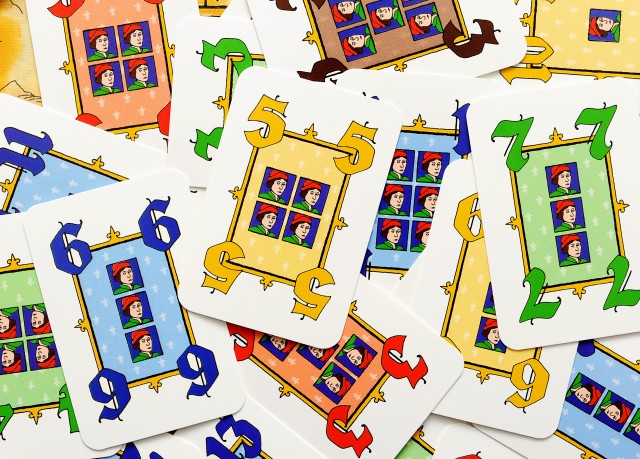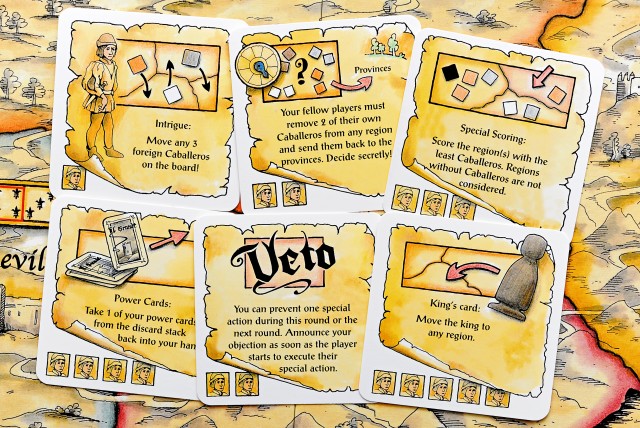Back in 1995 something very special was happening in the board game world. There was a little release called The Settlers of Catan that took Europe – and shortly afterwards, North America – by storm. It was the beginning of a board game renaissance, the effects of which are still being felt today. That same year, El Grande by Wolfgang Kramer and Richard Ulrich debuted. It was well loved and well respected on its release, but didn’t share the same global success felt by Catan. For those in the know, El Grande is pretty strongly regarded, but with so many new games out there, it’s been lost in the shuffle a bit.
El Grande merges area majority with action selection. Players are transported to 15th century Spain to battle over nine different regions. Their Grande (big  cube) is assigned a home region on the board. Throughout the game they will deploy their Caballeros (represented by little cubes) across Spain in an effort to dominate the different areas. Over the course of nine (or six for a shorter game) rounds control of the regions is fought over. Most regions will award points for three players with the most Caballeros present. There are three different scoring phases during the game, after the third, sixth and ninth rounds.
cube) is assigned a home region on the board. Throughout the game they will deploy their Caballeros (represented by little cubes) across Spain in an effort to dominate the different areas. Over the course of nine (or six for a shorter game) rounds control of the regions is fought over. Most regions will award points for three players with the most Caballeros present. There are three different scoring phases during the game, after the third, sixth and ninth rounds.
As you can imagine the king was a pretty important figure in Spain during the 15th century, and the same could be said for the the king in El Grande. At the start of the game he is randomly placed in a region on the board. He will determine where new Caballeros can be placed. Any adjacent region to the king is fair game!
Players start the game with power cards ranked 1-13. One at a time they will play one of their power cards to determine turn order and also how many Caballeros may be moved into your personal supply. Having a good compliment of Caballeros is super important! The higher the power card you play the sooner you will go in turn order, but the less Caballeros you will gain access to. Once turn order has been established players will get a chance to take one of the available actions and add Caballeros to the map.
The actions available are represented by cards. The top card on four different piles are flipped each round as well as the King’s card which is available each  round. The piles are numbered 1-4 in reference to how many Caballeros they allow you to add to the board. So, if you take the #2 action card you get to perform its action and add two Caballeros to the board. Some of the actions will allow you to move or remove Caballeros from the board. Others can trigger a special scoring of a region. The King’s card allows you to place the King in the region of your choice. Once all of the actions have been executed the next action card in each stack is flipped and a new round begins. The player who played last in the previous round is first to choose a power card.
round. The piles are numbered 1-4 in reference to how many Caballeros they allow you to add to the board. So, if you take the #2 action card you get to perform its action and add two Caballeros to the board. Some of the actions will allow you to move or remove Caballeros from the board. Others can trigger a special scoring of a region. The King’s card allows you to place the King in the region of your choice. Once all of the actions have been executed the next action card in each stack is flipped and a new round begins. The player who played last in the previous round is first to choose a power card.
Oh man! I’ve forgotten the cardinal rule of the game! Remember the Castillo! The Castillo is a cool 3-D castle that sits on an island off the coast of Spain. Any time that you’re able to add Caballeros to the board you can instead drop some or all of them into the Castillo announcing the number you place in there. The tall walls of the Castillo will conceal the exact number of cubes within, so it’s a good idea to try and keep track of how many your opponents put in there and remember the Castillo yourself. It can be a game changer.
In each of the scoring rounds the Castillo is resolved first. Players will score points for their Caballeros present and then they get a chance to redeploy  those forces. Using their secret disc each player will get to select what region all of those Caballeros will be transferred to. Having a lot of Caballeros to deploy can mean the difference between winning or losing a region.
those forces. Using their secret disc each player will get to select what region all of those Caballeros will be transferred to. Having a lot of Caballeros to deploy can mean the difference between winning or losing a region.
Each player gets points for being first, second, and usually third in terms of control of the region. They’ll also get a bonus two points for having the most Caballeros in their home region (the one with their Grande) and a bonus two points for the King’s region. After nine rounds the winner is the one with most over points. Pretty simple.
That’s actually the big draw with El Grande – its simple elegance. Now, elegance is a word that gets thrown around a lot with board game reviewers and it means different things to different people. To me, an elegant game has a cohesiveness between its rules and mechanics, without being too clunky or overly complicated. El Grande perfectly marries majority control and action selection in a game that is tense, but straightforward. You’ll never have more fun backstabbing your friends.
El Grande came out years before other games that we consider classics, like Carcassonne, Princes of Florence and Puerto Rico. It still easily holds up against today’s games, even if it’s not nearly as flashy as some. But why talk about it now? In part is coincides with the 20 year anniversary last year and Z-Man’s release of the El Grande Big Box to celebrate that. Mostly though, it’s just to recognize what a great game this is. Too often classics get passed over in our cult of the new mentality. In 1995, I certainly wasn’t playing games at the frequency I am now and I’m pretty happy (and lucky) that not too long ago someone turned me onto El Grande. It’s funny how often that can happen in our hobby, but with some many games coming out every year, it’s impossible to play them all. El Grande certainly is one of my favourite games of all time and even if it doesn’t belong on everyone’s shelf, do yourself a favour and give it a shot. You won’t be sorry!
Comments
No comments yet! Be the first!